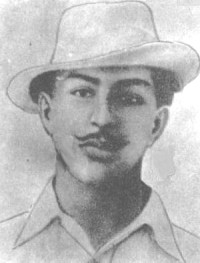Bh
Bhagavan, Ramalingam Saravana (1927– 1989)
Nickname: “Baggy”
Born Mullativu, Ceylon. Educated Trinity College, Kandy, and Royal College, Colombo. Joined Lanka Sama Samaja Party, 1942. Member, Bolshevik Leninist Party of India, 1942-50. Co-editor (with Vijaya Vidyasagara), Samasamajist . Translated and published Marxist writings for Lanka Sama Samaja Party in Sinhala, Tamil, and English under the Star Press imprint. Entered legal profession 1956 and worked as a solicitor. Organizing Secretary, Wellawatte Spinning and Weaving Mills Union. Helped build the United Port Workers Union. Member Central Committee, Lanka Sama Samaja Party. Founding member, Lanka Sama Samaja Party (Revolutionary), 1964. Editorial Board, Young Socialist , 1966-67. Author: An Introduction to the Philosophy of Marxism (1962). Co-author (with Sydney Wanasinghe) of a biography of Trotsky in Sinhala, 1990.
Compiled by Charles Wesley Ervin

Singh, Bhagat (1907-1931)
Bhagat Singh was born on 27 September 1907.
Indian revolutionary and a major figure in the Indian independence movement of the early Twentieth Century. Singh was active in revolutionary struggle from an early age and he was briefly affiliated with the Mohandas Ghandi’s “Non-Cooperation” movement, although Singh would break with Ghandi’s philosophy of non-violent resistance later in life.
Singh embraced atheism and Marxism-Leninism and integrated these key components into his philosophy of revolutionary struggle. Under his leadership, the Kirti Kissan Party was renamed the Hindustan Socialist Republican Organization. As Singh and his organization rose to new prominence in the Indian independence movement, they became the focus of public criticism from Ghandi himself, who disagreed with their belief that violence was a necessary and vital component of revolutionary struggle.
Singh’s secularism was perhaps his most important contribution to the socialist and independence struggles. During those turbulent times, British Imperialism used every tactic to create antagonism among the different religions of India, especially between Hindus and Muslims. The Sanghatan and Shuddi Movements among Hindus; and tableegh and many sectarian movements in Muslims bear witness to the effects of this tactic. Bhagat Singh removed his beard which was a violation of Sikh religion, because he did not want to create before the public the image of a ‘Sikh’ freedom fighter. Nor did he want to be held up as a hero by the followers of this religion. He wanted to teach the people that British Imperialism was their common enemy and they must be united against it to win freedom.
On April 8, 1924, Baghat Singh and his compatriot B. K. Dutt hurled two bombs on to the floor of the Central Delhi Hall in New Delhi. The bombs were tossed away from individuals so as not to harm anyone and, in fact, no one was harmed in the ensuing explosions. Following the explosions, Singh and Dutt showered the hall with copies of a leaflet that later was to be known as “The Red Pamphlet.” The pamphlet began with a passage which was to become legendary in the Indian revolutionary struggle:
“It takes a loud voice to make the deaf hear, with these immortal words uttered on a similar occasion by Vaillant, a French anarchist martyr, do we strongly justify this action of ours.”
Singh and Dutt concluded the pamphlet with the phrase “Long Live the Revolution!” This phrase (translated from “Inquilab Zindabad!” became one of the most enduring slogans of the Indian Independence Movement.
Singh and Dutt turned themselves in following the bombing incident. Following the trial, they were sentenced to “transportation for life” and while imprisoned, Singh and Dutt became outspoken critics of the Indian penal system, embarking on hunger strikes and engaging in agitation and propaganda from within the confines of the prison. Shortly after the commencement of his prison sentence, Singh was implicated in the 1928 death of a Deputy Police Superintendent. Singh acknowledged involvement in the death and he was executed by hanging on 23 March 1931.
Bhagat Singh is widely hailed as a martyr as a result of his execution at the hands of oppressors and, as such, he is often referred to as “Shaheed (Martyr) Bhagat Singh.”
Mike Bessler, 2006
Further Reading: Bhagat Singh Archive